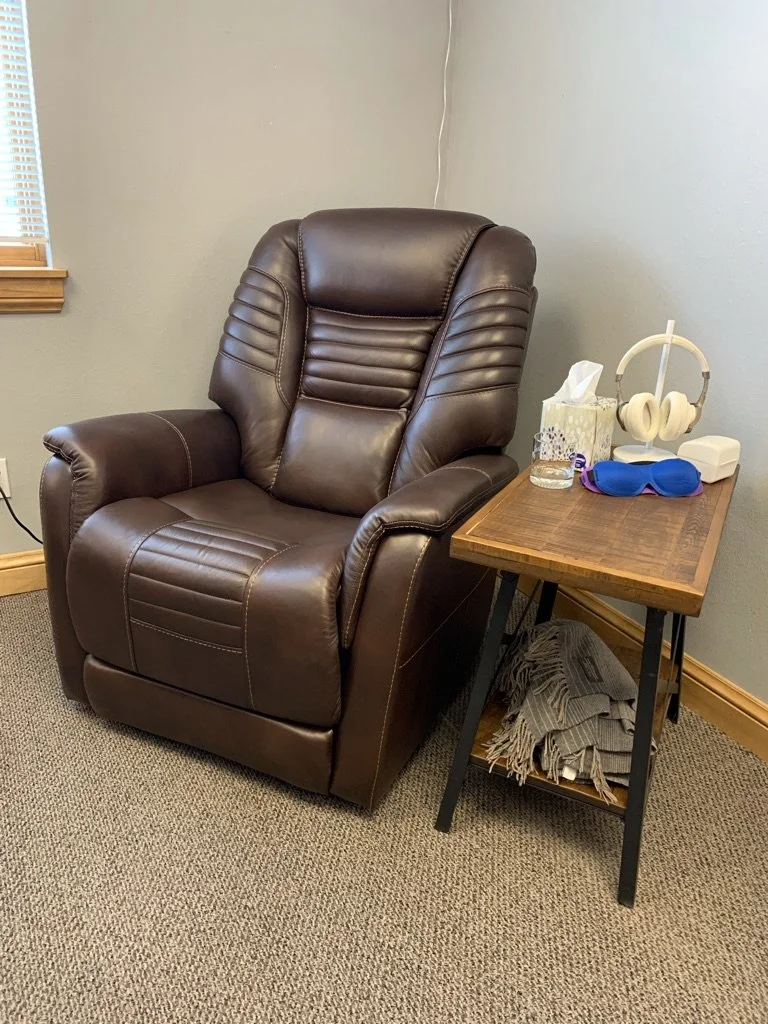What Happens During a Ketamine-Assisted Psychotherapy Session
Ketamine-Assisted Psychotherapy (KAP) is a relatively new way to do therapy. It combines talk therapy with a ketamine prescription to create a powerful way to treat depression, trauma, substance abuse and other issues. It’s also an effective way to get the most out of therapy. Instead of “just talking”, having ketamine in your system while working with your therapist is like being wrapped in a warm and comforting blanket while you talk through difficult and emotional material. So what exactly happens in the ketamine session with a trained therapist?
The Anatomy of a Ketamine Therapy Session
Where the magic happens
A comfortable way to have a ketamine journey.
Typically after a client has met with their therapist a few times, some goals and intentions are made for the ketamine work. A client brings in their ketamine prescription to the therapist’s office (we work here at Psychedelic Growth with rapid-dissolving tablets, other clinics use an infusion or injection to deliver ketamine).
A ketamine therapy session is longer than a normal talk therapy session (2.5-3 hours, vs. the usual 1 hour). There’s time to get settled, review intentions and calm some pre-dosing nerves, which is very normal especially for the first session. Your therapist will discuss how the session will go, take your blood pressure and assist you in taking your dose.
The tablets we work with dissolve under your tongue. You swish it around in your mouth for about ten minutes to ensure you have absorbed the medicine. Then you spit out any remaining medicine (to reduce any risk of nausea). Then you lie back, get comfortable and your therapist plays pre-selected calming music and provides an eyeshade.
This is where the session really takes off. As the medicine works it way through your brain, most people report feeling calm, peaceful, introspective, gentle and carefree. There may also be times of processing emotions like sadness and grief. Some clients cry (that’s okay!).
Your therapist is always with you, holding space and being available to talk if you want to. Most people feel the effects of the ketamine wear off after about 45 minutes. Usually they take off their eyeshades, check in with their therapist and have a drink and a snack. There’s lots of time afterwards to talk about what the client felt and thought about while they were in the ketamine experience.
Themes vary from client to client, but since you have been working with this therapist, they are up to speed on your concerns, issues and things you’re working though. Often, the themes that come up are about healing; healing relationships with other or themselves, healing from past trauma, and having the healing experience of depression finally lifting.
In between the ketamine dosing session, clients have regular check-ins and talk therapy in order to build upon the healing that occurs in the ketamine sessions. This is called integration work. It usually involves sorting through thoughts and feelings in light of the new perspective that ketamine can bring. It also usually touches upon action steps to continue healing.
Ketamine As a Booster for Therapy
Best practice continues to be combining talk therapy with ketamine. Often, what blocks progress in therapy (and in everyday life with depression, anxiety or other mental illness) is negative thoughts. This can look like blaming yourself, belittling your accomplishments, comparing yourself negatively with others.
Ketamine works on the brain circuits that influence negative thinking. As the constant drumbeat of negativity begins to quiet down, therapy becomes more productive. It’s easier to break old habits and create new, healthier habits. Emotions become less overwhelming and threatening. Feeling become more available and easier to work though and move through. Making decisions is easier and quicker. Self-destructive patterns fade away.
In short, ketamine is a medicine that turns down the volume on shame, self-reproach and the desire to hurt yourself.
How Long Does It Take for Ketamine to Work?
Ketamine is a fast-acting medicine. Traditional antidepressants take 4-6 weeks of daily use to take effect. Ketamine works almost immediately in the brain, that’s why you can feel it during the dosing session.
Most people feel significant relief after about 4 doses (given the dose is at an effective level). It can take 1 or 2 session to find that correct dose; the sweet spot that allows for healing. Most people are done with their ketamine treatment after 6-8 doses.
What If I Already Have a Therapist?
We are happy to provide ketamine dosing sessions while you continue to work with your regular therapist. We often collaborate with therapists, allowing clients to add ketamine to their treatment plan.
Is Ketamine Therapy Right for Me?
If you want to explore whether ketamine therapy is right for you, please contact us.




